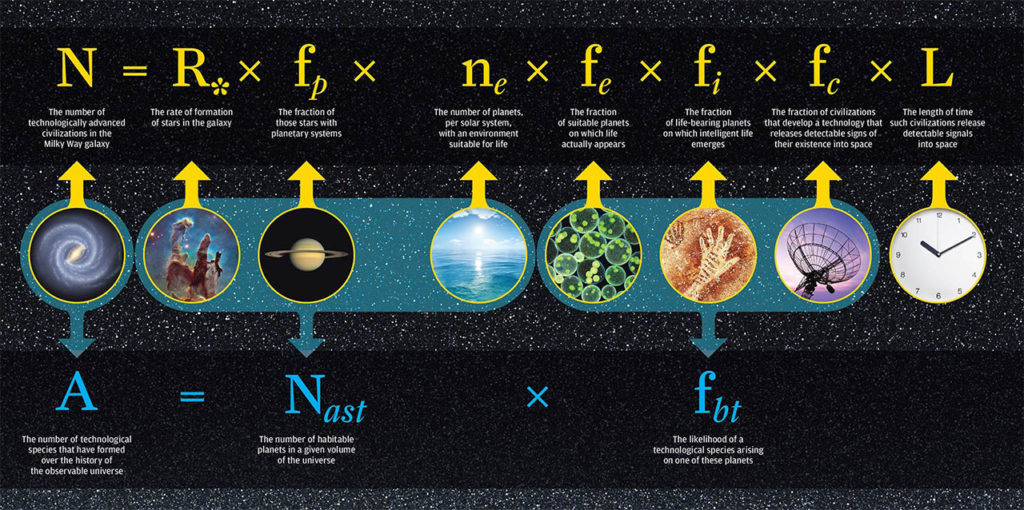
I learned this today. The Drake equation is a way of trying to guess how many intelligent, communicating extraterrestrial civilizations there might be in the Milky Way Galaxy.
Frank Drake is an astronomer who helped found SETI, the Search for Extraterrestrial Intelligence. He co-designed the Pioneer plaque with Carl Sagan in 1972. The Pioneer plaques are a pair of gold plaques that were put on the Pioneer 10 and Pioneer 11 spacecraft in the early 1970s. The two Pioneer spacecraft left our Solar System in the mid-1980s and have been flying through space. They are directed at other galaxies but will not arrive there for a million years or more. Each Pioneer plaque has a nude figure of a human male and female and various information about us and where we have come from. If either of the plaques are discovered, it should give the discovers enough information to come and find us. Whether we would want them to come and find us is another matter.
That led Frank Drake to his equation. He wanted to try to work out the probability of there being intelligent life in the universe that could find the plaque, or that could be able to contact us. He came up with 8 different variables that need to be considered to work out this probability. It is obviously hypothetical because nobody can know the exact number for each variable.
This is the equation:
N = R*・fp・ne・ fl・fi・fc・L
This equation does not have an answer, and it is not supposed to have an answer. It was designed to make people think about the likelihood of intelligent life being out there. Still, after he had designed it, Drake plugged in the numbers he had in the 1960s to get a rough answer. Since the 1960s, astronomy has improved to the point where more accurate numbers can be used in some of the fields, but not all of them. And, of course, they are still only educated guesses.
N is the number of civilizations in our galaxies that might be capable of communication with us. This is the number we are trying to calculate.
R* is the average rate of star formation in the Milky Way Galaxy. The figure for this is thought to be 1.5 to 3 stars formed per year over the life of the galaxy.
fp is the fraction of those stars that have planets. Observation of the galaxy seems to indicate that the number for this is 1. Stars appear to be almost always orbited by at least one star. To have a rogue star with no planets seems to be the exception. This probably has something to do with the way stars form.
ne is the average number of planets that can potentially support life per star that has planets. This is impossible to know, and different people have different figures. In 2013, astronomers reported that there could be 40 billion Earth-sized planets orbiting stars in a habitable zone.
fl is the fraction of planets that could support life that actually develop life. This is hard to know because the only example we have of where life has started on a planet is our planet. We can see that life started pretty much as soon as the planet became hospitable to life, which would suggest that life is quite common if the conditions are right. However, there is inherent bias with this because we can only look at our planet because life has started here. If we were to find evidence of life on Mars or another planet, we could revise this up. Some people say this is 0 and some say it is 1, a certainty.
fi is the fraction of these planets that go on to develop intelligent life. Different people view this differently as well. Some people say that as we are the only intelligent life that has evolved on our planet, this number should be low. They say that was intelligence common, more intelligent lifeforms would have developed. Others say that life becomes more complex with time, so the evolution of intelligent beings is a certainty.
fc is the fraction of intelligent civilizations that develop the technology to release detectable signals into space. This is impossible to know, but we can look at our own planet. We don’t send out many conscious signals, but the current technology we use on Earth could be detectable from space. However, it has taken us a million years since humans evolved to reach this point.
L is the length of time that such civilizations can release their signals into space. This is really the important one. If civilizations wipe themselves out, then none of the other points really matter. However, some people think that intelligent civilizations slowly overcome all of their difficulties and could survive for billions of years. If that is true, then the Milky Way Galaxy is slowly filling with intelligent life.
So, Frank Drake came up with an equation to work out the probability of intelligent life that can communicate with us existing on other planets. He looked at the average number of stars that are formed a year ⇒ the number that might have planets ⇒ the number of those planets that could support life ⇒ the number of planets that could support life that do develop life ⇒ the number of those planets where the life is intelligent life ⇒ the number of intelligent civilizations that develop the technology to send signals ⇒ the length of time those civilizations exist. There is no one answer to this but it is a good thought experiment to get people thinking about the possibility of intelligent life out there. And this is what I learned today.
Image: The University of Rochester
Sources
https://en.wikipedia.org/wiki/Pioneer_plaque
https://en.wikipedia.org/wiki/Pioneer_10
https://en.wikipedia.org/wiki/Pioneer_11
https://www.pbs.org/lifebeyondearth/listening/drake.html
https://www.pbs.org/lifebeyondearth/listening/drake.html
https://en.wikipedia.org/wiki/Frank_Drake
https://www.seti.org/drake-equation-index
https://www.space.com/25219-drake-equation.html
https://exoplanets.nasa.gov/news/1350/are-we-alone-in-the-universe-revisiting-the-drake-equation/
